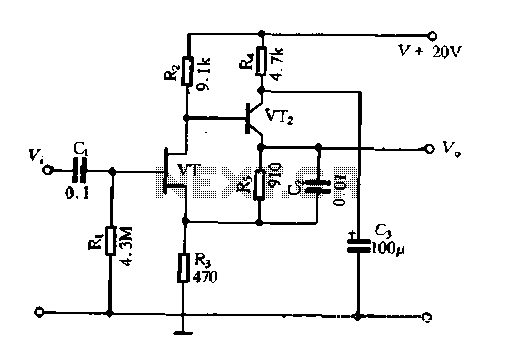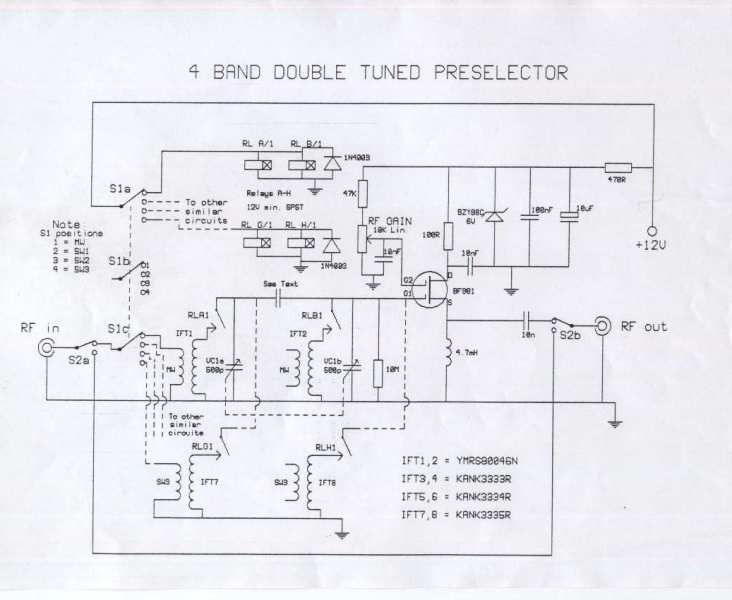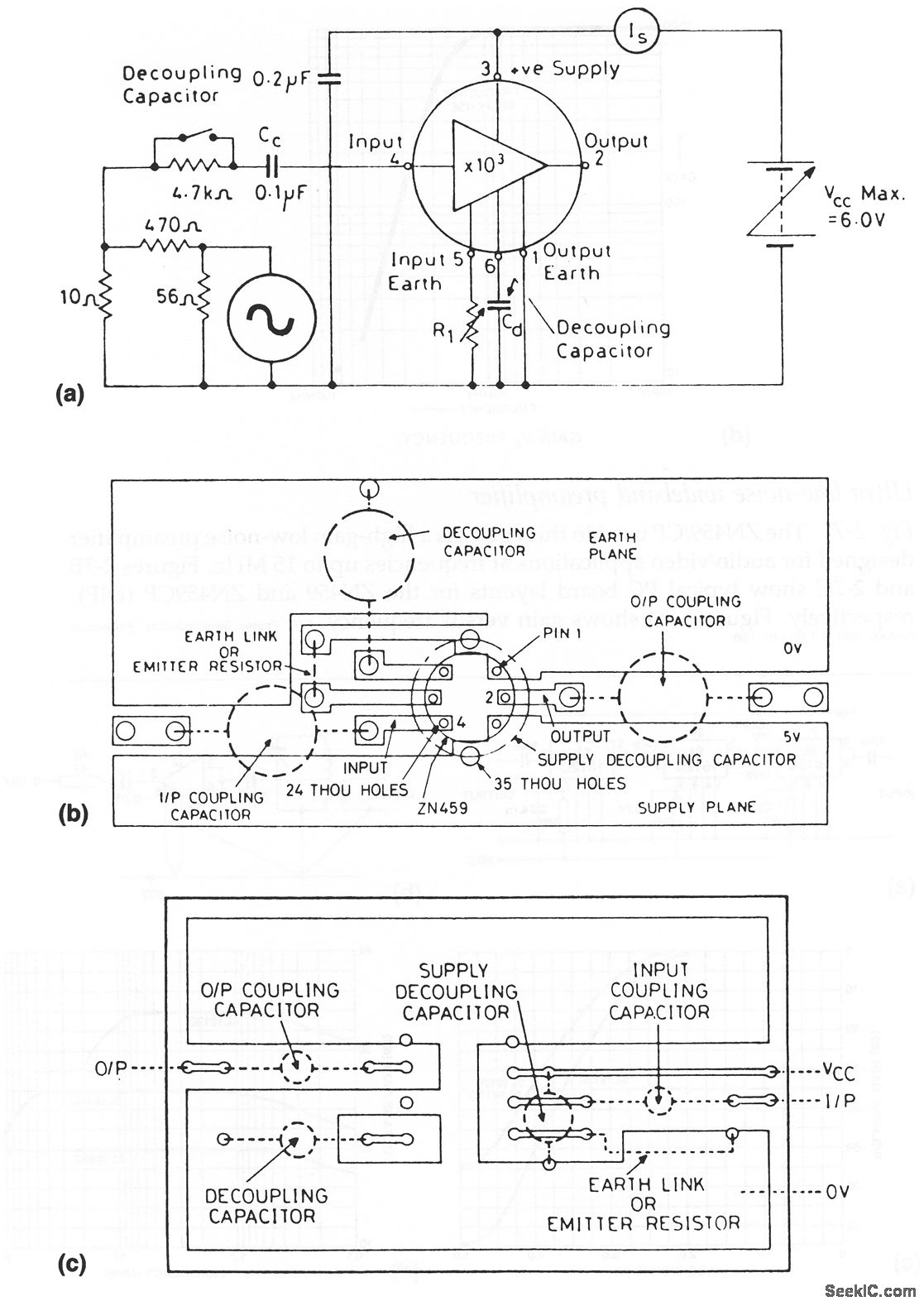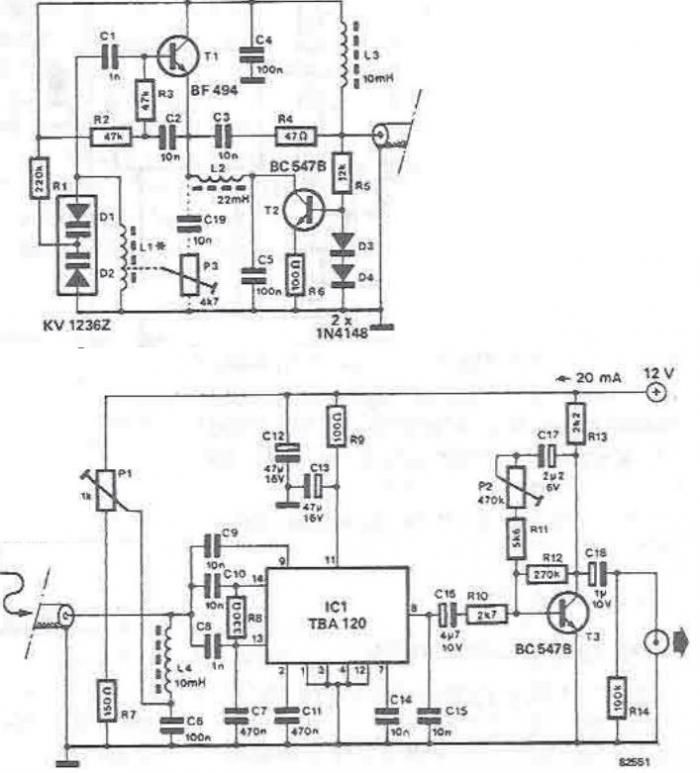
Aircraft band / AM Receiver with PIC16F84
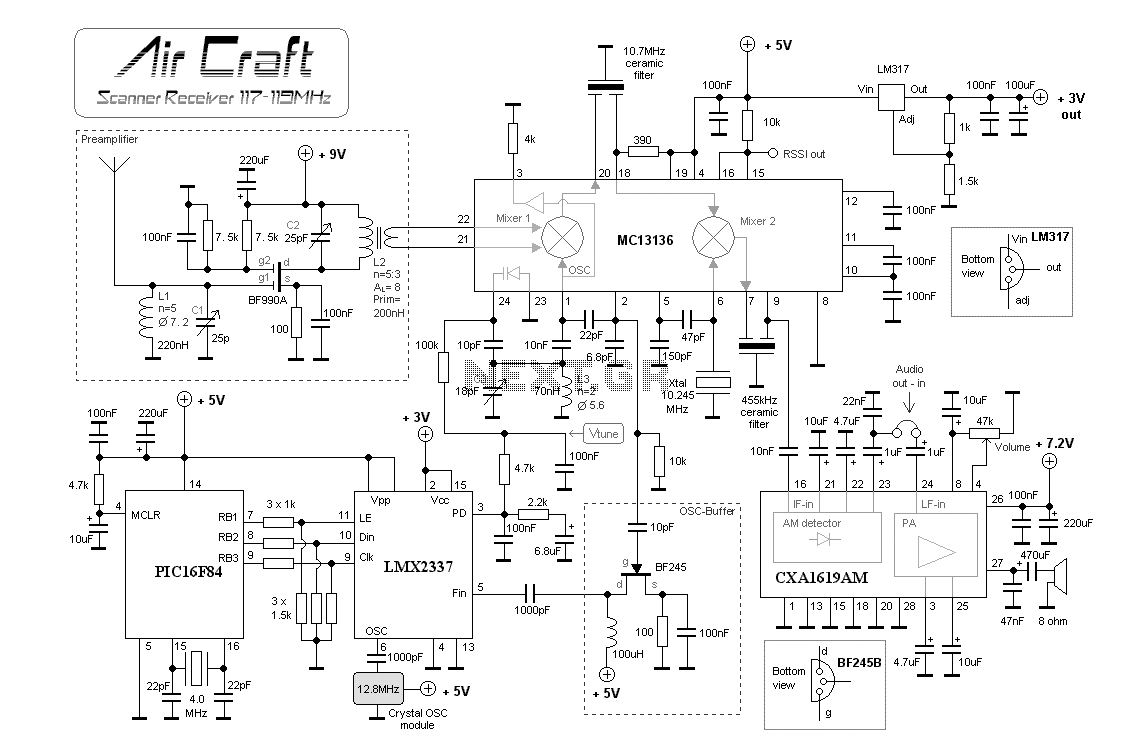
Aircraft communication is still AM modulated and the frequency is about 110-125 MHz. What differs this construction from my two previous is that I have implemented many blocks into one circuit and therefore I will have superior performance with fewer components. The receiver is working with a Frequency Synthesizer which gives very stable reception and it is easy to change frequency as well. The RF signal is first amplified before it enters mixer 1. To mixer 1 is also a VCO (Voltage Controlled Oscillator). The tuning voltage to the oscillator is controlled by the PLL synthesizer. There is also a feedback from the output of the VCO to the PLL synthesizer. The synthesizer will control the VCO-voltage until the frequency is locked to the desired frequency you have programmed into the PIC circuit. The product of mixer 1 is filtered into a standard 10.7 MHz ceramic filter and then enters mixer 2. At mixer 2, the RF will be mixed with a constant frequency from a crystal (10.245 MHz). The product will enter a new ceramic filter and finally into an AM demodulator which brings out the audio.
To the left, you will find the preamplifier. It is based on a dual-gate FET (You can use almost any dual-gate FET). At Gate 1, we have the antenna input. L1 and C1 will tune the antenna for best performance. To find a super perfect antenna match, you can solder the antenna to a tap-point of L1. Gate 2 is biased to give high gain. At the drain, you will find another tuned circuit L2 and C2. This circuit should also be tuned for best performance. L2 is a transformer slug-tuned inductor. An inductor with an AL value of 7 with 5 turns primary will yield 175 nH. This inductor transforms the RF to the secondary side with 3 turns which is connected to mixer 1.
In the MC13136, an oscillator is found at pins 1 and 2. This oscillator is connected to mixer 1. A tuned circuit connected to C3 and L3 enhances this oscillator. To make this oscillator voltage-controlled, a varicap diode is placed between pins 24 and 23. The capacitance of this diode is dependent on the voltage applied across it. A small 10 pF capacitor connects the varicap and C3, allowing frequency adjustment by applying a voltage to pin 24.
In mixer 2, the RF signal flows from mixer 1 through the ceramic filter into mixer 2. At pins 5 and 6, a fixed oscillator with a crystal operates at 10.245 MHz. The 455 kHz IF passes through a ceramic filter to the AM demodulator. At pin 15, a voltage indicates the strength of the input RF signal (RSSI), which can control a squelch unit.
The PLL synthesizer is a critical component in this design. At pin 2, a 10 kΩ resistor is connected to ground to amplify the oscillation current. A fraction of the oscillation energy passes through a 10 pF capacitor to a FET buffer, preventing glitches from the PLL from affecting the VCO and avoiding excessive loading on the VCO. The VCO frequency is amplified at pin 5 of the PLL, while pin 3 serves as the phase detector output. The PLL regulates the current at this pin, and with capacitors and resistors, a voltage is fed back to the varicap at pin 24 of the MC13136 through a 100 kΩ resistor. Monitoring this voltage with a voltmeter will demonstrate how the system maintains frequency lock. Aircraft communication is still AM modulated and the frequency is about 110-125 MHz. What differ this construction from my two previous is that I have implemented many blocks into one circuit and therefore I will have superior performance with less components. The receiver is working with a Frequency Synthesizer which gives a very stable reception and it is easy to change frequency as well.
The RF signal is first amplified before it enters mixer 1. To mixer1 is also a VCO (Voltage Controlled Oscillator). The tuning voltage to the oscillator is controlled by the PLL synthesizer. There is also a feedback from the output of the VCO to the PLL synthesizer. The synthesizer will control the VCO-voltage until the frequency is locked to the desired frequency you have programmed into the PIC circuit. The product of the mixer 1 is filtered into a standard 10.7MHz ceramic filter and then enter mixer 2.
At mixer 2 the RF will be mixed with a constant frequency from a crystal (10.245MHz). The product will enter a new ceramic filter and finally into a AM demodulator which brings out the audio. To the left you will find the preamplifier. It is based on a dualgate fet (You can use almost any dualgate fet). At Gate 1 we have the antenna input. L1 and C1 will tune the antenna for best performance. To find super perfect antenna match you can solder the antenna to a tap-point of L1. I can not tell you where to put the tap, you have to experiment yourself. Gate 2 is biased to give high gain. At drain you will find another tuned circuit L2 and C2. This circuit should also be tuned for best performance. I have chosen L2 to be a transformer slugtuned Inductor. I have an inductor with AL value of 7. With 5 turns primary I will get 5*5*7=175nH. This inductor transform the RF to the secondary side 3 turns which is connected to mixer 1. Mixer 1 and Mixer 2: In the MC13136 you will find an oscillator at pin 1 and 2. This oscillator is connected to mixer 1. To pin 1 and 2 is a tuned circuit connected C3 and L3. How to make this oscillator voltage controlled? Between pin 24 and 23 is a varicap diod. The capacitans of this diod is dependent of the voltage over it. Look at the schematic and you will find a small 10pF capacitor connecting the varicap and the C3. So, by applying a voltage to pin 24 you will now be able to change the frequency a few MHz. Forget about that now and look at mixer 2. You see how the RF signal goes from mixer 1 through the ceramic filter into mixer 2. At pin 5 and 6 you will find a fixed oscillator with a crystall. This oscillator is always 10.245MHz (hopefully). The 455KHz IF is now passing a ceramic filter and to the AM demodulator. At Pin 15 you will have a voltage depending on the strength of the input RF signal (RSSI). This voltage can control a squelsh unit. PLL synthesizer: Many people get scared when it comes to PLL stuff. Don't worry I will explain to you. Earlier I told you that the oscillator was at pin 1 and 2. Well, at pin 2 I have added a 10k resistor to ground because I want to amplify the oscillation current. A fraction of the oscillation energy slips away through a 10pF capacitor down to a FET buffer. This buffer is needed because I don't want glitches from the PLL go back into the VCO and I don't want to load the VCO to much either.
At pin5 of the PLL I will have the VCO frequency amplified. Pin 3 of the PLL is the Phase detector output. The PLL will regulate the current at this pin and with some capacitor and resistor I will have a voltage which is feed back to the varicap at pin 24 of the MC13136 through a 100k resistor. If you want you can probe (schematic Vtune) this voltage with a voltmeter and you will see how it keeps the frequency locked.
🔗 External reference
To the left, you will find the preamplifier. It is based on a dual-gate FET (You can use almost any dual-gate FET). At Gate 1, we have the antenna input. L1 and C1 will tune the antenna for best performance. To find a super perfect antenna match, you can solder the antenna to a tap-point of L1. Gate 2 is biased to give high gain. At the drain, you will find another tuned circuit L2 and C2. This circuit should also be tuned for best performance. L2 is a transformer slug-tuned inductor. An inductor with an AL value of 7 with 5 turns primary will yield 175 nH. This inductor transforms the RF to the secondary side with 3 turns which is connected to mixer 1.
In the MC13136, an oscillator is found at pins 1 and 2. This oscillator is connected to mixer 1. A tuned circuit connected to C3 and L3 enhances this oscillator. To make this oscillator voltage-controlled, a varicap diode is placed between pins 24 and 23. The capacitance of this diode is dependent on the voltage applied across it. A small 10 pF capacitor connects the varicap and C3, allowing frequency adjustment by applying a voltage to pin 24.
In mixer 2, the RF signal flows from mixer 1 through the ceramic filter into mixer 2. At pins 5 and 6, a fixed oscillator with a crystal operates at 10.245 MHz. The 455 kHz IF passes through a ceramic filter to the AM demodulator. At pin 15, a voltage indicates the strength of the input RF signal (RSSI), which can control a squelch unit.
The PLL synthesizer is a critical component in this design. At pin 2, a 10 kΩ resistor is connected to ground to amplify the oscillation current. A fraction of the oscillation energy passes through a 10 pF capacitor to a FET buffer, preventing glitches from the PLL from affecting the VCO and avoiding excessive loading on the VCO. The VCO frequency is amplified at pin 5 of the PLL, while pin 3 serves as the phase detector output. The PLL regulates the current at this pin, and with capacitors and resistors, a voltage is fed back to the varicap at pin 24 of the MC13136 through a 100 kΩ resistor. Monitoring this voltage with a voltmeter will demonstrate how the system maintains frequency lock. Aircraft communication is still AM modulated and the frequency is about 110-125 MHz. What differ this construction from my two previous is that I have implemented many blocks into one circuit and therefore I will have superior performance with less components. The receiver is working with a Frequency Synthesizer which gives a very stable reception and it is easy to change frequency as well.
The RF signal is first amplified before it enters mixer 1. To mixer1 is also a VCO (Voltage Controlled Oscillator). The tuning voltage to the oscillator is controlled by the PLL synthesizer. There is also a feedback from the output of the VCO to the PLL synthesizer. The synthesizer will control the VCO-voltage until the frequency is locked to the desired frequency you have programmed into the PIC circuit. The product of the mixer 1 is filtered into a standard 10.7MHz ceramic filter and then enter mixer 2.
At mixer 2 the RF will be mixed with a constant frequency from a crystal (10.245MHz). The product will enter a new ceramic filter and finally into a AM demodulator which brings out the audio. To the left you will find the preamplifier. It is based on a dualgate fet (You can use almost any dualgate fet). At Gate 1 we have the antenna input. L1 and C1 will tune the antenna for best performance. To find super perfect antenna match you can solder the antenna to a tap-point of L1. I can not tell you where to put the tap, you have to experiment yourself. Gate 2 is biased to give high gain. At drain you will find another tuned circuit L2 and C2. This circuit should also be tuned for best performance. I have chosen L2 to be a transformer slugtuned Inductor. I have an inductor with AL value of 7. With 5 turns primary I will get 5*5*7=175nH. This inductor transform the RF to the secondary side 3 turns which is connected to mixer 1. Mixer 1 and Mixer 2: In the MC13136 you will find an oscillator at pin 1 and 2. This oscillator is connected to mixer 1. To pin 1 and 2 is a tuned circuit connected C3 and L3. How to make this oscillator voltage controlled? Between pin 24 and 23 is a varicap diod. The capacitans of this diod is dependent of the voltage over it. Look at the schematic and you will find a small 10pF capacitor connecting the varicap and the C3. So, by applying a voltage to pin 24 you will now be able to change the frequency a few MHz. Forget about that now and look at mixer 2. You see how the RF signal goes from mixer 1 through the ceramic filter into mixer 2. At pin 5 and 6 you will find a fixed oscillator with a crystall. This oscillator is always 10.245MHz (hopefully). The 455KHz IF is now passing a ceramic filter and to the AM demodulator. At Pin 15 you will have a voltage depending on the strength of the input RF signal (RSSI). This voltage can control a squelsh unit. PLL synthesizer: Many people get scared when it comes to PLL stuff. Don't worry I will explain to you. Earlier I told you that the oscillator was at pin 1 and 2. Well, at pin 2 I have added a 10k resistor to ground because I want to amplify the oscillation current. A fraction of the oscillation energy slips away through a 10pF capacitor down to a FET buffer. This buffer is needed because I don't want glitches from the PLL go back into the VCO and I don't want to load the VCO to much either.
At pin5 of the PLL I will have the VCO frequency amplified. Pin 3 of the PLL is the Phase detector output. The PLL will regulate the current at this pin and with some capacitor and resistor I will have a voltage which is feed back to the varicap at pin 24 of the MC13136 through a 100k resistor. If you want you can probe (schematic Vtune) this voltage with a voltmeter and you will see how it keeps the frequency locked.
🔗 External reference
